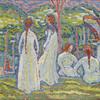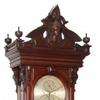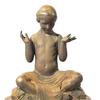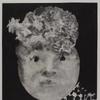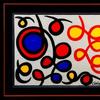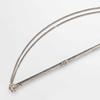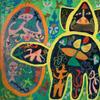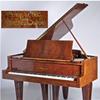American Folk Art Museum presents PAA Joe: Gates of No Return
- NEW YORK, New York
- /
- October 17, 2018
(New York, NY, October 17, 2018) The exhibition Paa Joe: Gates of No Return will be presented at the American Folk Art Museum (AFAM) from October 30, 2018 to February 24, 2019. The exhibition will feature seven large-scale architectural models, created by artist Paa Joe (1947, Ghana), of still-existing castles and forts on the Gold Coast of West Africa, now Ghana. From the sixteenth through nineteenth centuries, these buildings were used as posts in the European gold trade and as way stations for more than six million Africans who were sold into slavery and sent on ships to the Americas and Caribbean. Discussions with Paa Joe and with collaborators who previously worked with him (Nana Oforiatta Ayim, Kristin Otto, Benjamin Wigley) permitted AFAM to enrich the exhibition with films, photographs, and other archival elements that provide context to the artist’s creative process and gives points of entry into the history of these charged historical sites.
Paa Joe crafted and painted these architectural models after several visits to each site. The seven imposing sculptures selected for the exhibition are among a group of thirteen models that were commissioned from Paa Joe by the late artist, collector, and art dealer Claude Simard (Jack Shainman Gallery, New York) when he visited Paa Joe’s Accra workshop in 2004. Still raw from the tragedy of 9/11, Simard approached this project politically and poetically as a way to connect two devastating historical events.
The curator of the exhibition, Valérie Rousseau, Ph.D., curator of self-taught art and art brut at AFAM, writes that “Once Africans were forced through these ‘gates of no return’ [an inscription written by Paa Joe on the models] in large, underground dungeons, they started an irreversible, perilous journey across the Atlantic—during which many died—into a life of slavery. These objects that symbolize human commodification, forced displacements, and unimaginable brutality are, as the Paa Joe described, ‘memories of the past. They stand as dark reminders for the whole world,’ a world still struggling with injustice, exploitation, and a pernicious system of racial inequality that has been perpetuated for centuries. These sculptures reactivate the ghosts of the voiceless haunting the foundation of these sites.”
Paa Joe is internationally known for his figurative coffins—ceremonial objects popularized in the 1950s among the Christian Ga people, drawn from the Ghanaian tradition of abeduu adekai, to assist one’s passage into the afterlife. The coffins take the shape of an animal, musical instrument, vehicle, or theme closely associated with the life of the individual who will be buried in them. Dr. Rousseau adds that, “Paa Joe’s architectural models draw clear parallels to the artist’s production of fantasy coffins, which are seen as vessels ferrying the dead into the afterlife, speaking to spirits separated from bodies in trauma.”
Joseph Tetteh Ashong, aka Paa Joe, is the nephew of Ghanaian figurative coffin maker Kane Kwei (1922–1992), with whom he started a ten-year apprenticeship when he was fifteen years old. Still active, Paa Joe has been building coffins since the 1970s, gaining recognition as being the most celebrated living artist of Ghana in the genre. Based in the greater Accra region, he is now assisted by his son, Jacob Tetteh-Ashong, who runs the workshop with him and continues his father’s legacy.
“The fantasy coffins that Paa Joe creates have a clear intention and are immediately buried underground with the deceased,” explains Jason T. Busch, director of AFAM. “The works in this exhibition serve a different, more complex, function. They stand as deeply felt testaments to a shattering history, provoking awareness, discussion, and perhaps the dream of a future where such events would be unimaginable.”
On October 21, 2018, Paa Joe will be honored by the Detroit Institute of Arts with the 2018 African Arts Recognition Award, which underlines the Ghanaian’s contributions to contemporary culture. Paa Joe has received international recognition in exhibitions since the 1980s, including the 1989 seminal Magicians of the Earth at the Centre Pompidou, Paris, and other presentations at the British Museum, the Victoria & Albert, and the Brooklyn Museum, among others. In 2016, he was the subject of a documentary film, Paa Joe & The Lion (Benjamin Wigley, ARTDOCS Ltd). Some of his coffins from American collections are featured in the current exhibition Shapes of the Ancestors: Bodies, Animals, Art, and Ghanaian Fantasy Coffins at the Masters Museum of World Cultures, Indiana University, Bloomington.
Public programs during the exhibition Paa Joe: Gates of No Return include the following:
Critical Walk-Through: Cy Gavin
November 8, 2018
Contemporary artist Cy Gavin will discuss his art and practice engaging with landscape, identity, and his family history in Bermuda, while exploring how they relate to the works of Paa Joe and John Dunkley. A Critical Walk-Through is a 40-minute guided tour that is meant to offer an alternative perspective to the works on view. It includes conversations with artists, scholars, and curators, providing an intimate opportunity to engage with the central themes and histories found in the artwork.
Curator’s Perspective Tour
November 20, 2018
Tour of the exhibition with curator Valérie Rousseau.
Walls Can Speak: Sites, Memorials, & Social Justice
December 12, 2018
In response to Paa Joe’s Slave Castles, this panel discussion will feature a conversation about current projects that encourage education and reflection on the histories and legacies of slavery. Speakers include Louis P. Nelson from University of Virginia, Sia Sanneh from the Equal Justice Initiative, and Cheryl Sterling from the City College of New York.
Film Screening: Paa Joe & The Lion
January 15, 2019
To celebrate exhibition artist Paa Joe and the culture of his native Ghana, AFAM will present a film screening of the documentary Paa Joe & The Lion, followed by a Q&A led by exhibition curator Valérie Rousseau, and a musical performance. A Ghanaian street snack reception, catered by Brooklyn-based Kelewele, will conclude the evening.
Exhibition credits
Paa Joe: Gates of No Return is supported in part by the David Davies and Jack Weeden Fund for Exhibitions, the Ford Foundation, the New York City Department of Cultural Affairs in partnership with the City Council, the New York State Council on the Arts with the support of Governor Andrew M. Cuomo and the New York State Legislature, and the Council for Self-Taught Art and Art Brut. Special thanks to the artist and his family, Jack Shainman and his gallery staff, and Kristin Otto and the Mathers Museum of World Cultures, Indiana University, Bloomington.
About the American Folk Art Museum
Founded in 1961, the American Folk Art Museum is the premier institution devoted to the aesthetic appreciation of traditional folk art and creative expressions of contemporary self-taught artists from the United States and abroad. The museum preserves, conserves, and interprets a comprehensive collection of the highest quality, with objects dating from the eighteenth century to the present. Admission to the museum is always free. For more information, please visit www.folkartmuseum.org
Contact:
Kate MerlinoAmerican Folk Art Museum
2129777295
kmerlino@folkartmuseum.org
2 Lincoln Square (Columbus Ave. at W. 66th St.)
Columbus Ave. at 66th St.
New York, New York
kmerlino@folkartmuseum.org
2125959533
American Folk Art Museum
About American Folk Art Museum
Founded in 1961, the American Folk Art Museum is the premier institution devoted to the aesthetic appreciation of traditional folk art and creative expressions of contemporary self-taught artists from the United States and abroad. The museum preserves, conserves, and interprets a comprehensive collection of the highest quality, with objects dating from the eighteenth century to the present. Admission to the museum is always free. For more information, please visit www.folkartmuseum.org





